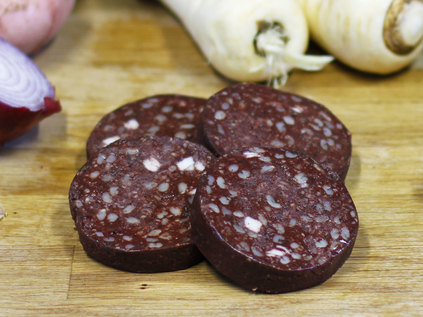Breakfast is by far my favourite meal. There are a number of reasons for this: firstly, it's usually accompanied by copious amounts of coffee. I love coffee. Don't misread this as "Mike likes coffee" - I appreciate it's subtleties and variations, I love the flavour and the ritual of making it, and I drink a ridiculous amount of it. I really like it a lot. Secondly, I'm an early riser - and by the time breakfast comes around, I'm really hungry. So, I don't suffer from the "hmm, I just woke up and I can't face food" thing which many people do. At breakfast time, I'm ready to eat! Finally, and rather simply, breakfast gets all the best foods. While you're probably inserting your own favourite breakfast food here - maybe a glistening link of Cumberland Sausage, a gloriously sticky waffle, a flaky croissant, a crisp edged sliver of back bacon or even a fluffy golden pancake - there's one food that I grew to love and which I feel the need to speak up for - and that is Black Pudding.
I grew up in a Midlands household where three generations of the family were living close together. My great-grandparents had come from farming stock and were certainly not squeamish or sentimental about livestock. My grandparents had survived the hardships of the Second World War too, and didn't believe in wasting food. As a child, I was more than comfortable with the idea that kidneys, pigs feet or chitterlings were being cooked in the kitchen when I arrived home from school. Some of them even smelled pretty good - but I never really tried them. They were 'grown up food' which I imagined I'd discover one day in some greasy-fingered right of passage. Black pudding fell squarely into this category, and stayed there for many years.
Travel broadens the mind in many ways, but for me one of the things it opened up was the joy of breakfast away from home. Perhaps in some lurid, plastic-tableclothed B&B or better yet on a train scudding north - it's hard to beat the travel breakfast. It's here I found myself experimenting with Orange Marmalade for the first time - something we rarely found at home - and it's here too I first tentatively tried black pudding. By turns smoothly unctuous and rather grainy in texture, the rich pork flavours lured me in. It was like the most bacon tasting bacon ever, essence of fried pig. In short, I was hooked. A lot of my travels took me to points north, and I found it easily enough. I remember strolling through Bury Market and seeing a stall entirely devoted to it. It even formed the basis, along with haggis, of one of the best hangover cures I've ever had one fuzzy-headed morning in Anstruther. Suddenly TV chefs were using it too - sliding it under seared scallops as a sort of middle class middle finger to 'poor food'. I could have found some woolly-headed Liberal offence to take here, but I was happy. More black pudding is a good, good thing.
But it's not always that simple. Black pudding has a pretty poor reputation in many quarters - which might be down to that complex class-related issue, or might just be because people don't enjoy the thought of fried pig's blood? Certainly, living as part of a joint UK/US household I've had my own acceptance challenged of what we delicately call 'offal', but what across the pond is known plainly and anti-euphemistically as 'organ meat'. But my position remains that if people taste the stuff, they'll at least decide on rational grounds - and sure enough, this household now has TWO pudding eaters! However, this ambivalence to the stuff causes some very strange things to happen. Firstly, its sudden vogue means it can be found on the menu everywhere - but the generally lack of enthusiasm means it's equally often the first thing to become unavailable. I'll often find my lips smacking at the thought of a slice of glistening, dark savoury pudding only to be told the chef is out of it. Or more strangely still, it appears to be listed as a standard breakfast item but simply doesn't appear. Is the assumption that it's OK to leave the pudding off because people don't like it? Or is it something more sinister? I've noted this and pointed it out as we travel around the country - and I think at first it sounded like I was being over-dramatic or pudding-paranoid, but after yet another non-appearance today I think my conspiracy theory is gaining more general acceptance here. Today's excuse? They are changing the menu but hadn't updated the card yet. But of course because it was 'only the black pudding' it didn't matter at all.
I realise that this is an awfully long tirade about something very, very unimportant. The very definition of the first world problem perhaps. But there is something slightly serious hiding here. The whole North/South divide thing hasn't gone away at all - it lurks in these strange culinary, linguistic and class prejudices which are riven through British life. But please, breakfast chefs of Britain, don't deprive me of this wondrous food on the basis of an amateur semiotic analysis. It tastes good, it's traditionally British and it's pretty darn cheap.
Give me back my Black Pudding!
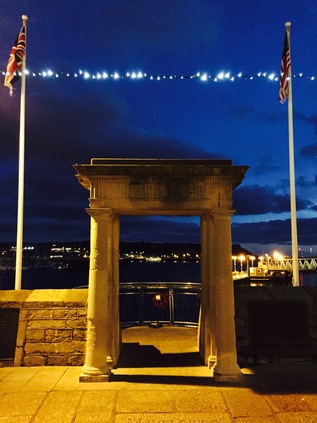
Heading West: We Ourselves Must Pilgrims Be
Posted in Travel on Wednesday 31st December 2014 at 10:11pm
It's been a long-standing tradition here to escape between Christmas and New Year. There's something about getting back out into the world after a period of staying indoors, eating and drinking which is both refreshing and cathartic. We'd thought about various trips, but as it had been a pretty hectic run up to Christmas, and with the changes around jobs and finances here it wasn't really clear if we'd manage to get away as we'd hoped. Eventually, things resolved themselves and I found a reasonably priced night at a hotel in Plymouth which I'd stayed at once for a First Great Western Customer Panel meeting. It's quite a while since I'd been to Plymouth - aside, that is from passing through on route to Cornwall or very occasionally changing trains here on jaunts around the South West. Since my last visit I'd read a lot more about the Abercrombie planned City Centre and I was keen to visit again. Also, with a tourist's eye I realised that I'd never quite made it to Plymouth Hoe or The Barbican. So, we set off around mid-day on a series of surprisingly quiet trains and in remarkably good weather. A swift change at Taunton, then a dash along the sea wall at Dawlish before cresting the South Devon Banks. It was very good to be back on the rails again.
We arrived and headed straight for the hotel to check-in and deposit our bags. At the head of the long boulevard of Armada Way, our hotel was a strange, concrete-clad example of the strangely dated architecture of the new city centre here. I'd recalled it as a drab, grey corner of the city - but once inside it was warm and clean, if a little dated. Armada Way too was looking a little better - a mixture of some very smart landscaping and some very effective Christmas decorations actually had it looking very bright and welcoming, so we headed out into the city as dusk fell. The long stretches of modernist blocks seemed softened by the silver-grey evening light and it was difficult not to feel comfortable here. Something of a contrast to previous visits. We pressed on through the impromptu fairground, still whirling and blasting ill-advised pop hits, and into the Civic Zone. The towering and ill-fitting Civic Centre, topped by a breathtaking roof sat across from the almost caricatured period-piece law courts and granite-blasted Guildhall. It is an uneasy mix - and not how the plan was meant to turn out of course, but it remains an interesting footnote in British architectural history - and despite being seen often as "how not to do things" all three buildings remain in use today.


After a leisurely dinner and a comfortable night, we set out to explore further. This time we crossed onto the Hoe, ascending to view the vast War Memorial which faces down the city defiantly, aligned on the long axis of Armada Way and elevated. Beyond this, the relocated Eddystone Lighthouse is a reminder of the naval pedigree of the city. As we crested the rise here, the vast sweep of the natural harbour at the mouth of the Tamar was evident. A silvery sky reflected on the water, the near-distance shrouded in rainclouds. It was an atmospheric and stirring view which somehow made complete sense of the city and it's curious alignment. We lingered for awhile before moving off towards the Royal Citadel, skirting it's forbidding stone walls along the waterfront to find our way back to The Barbican.
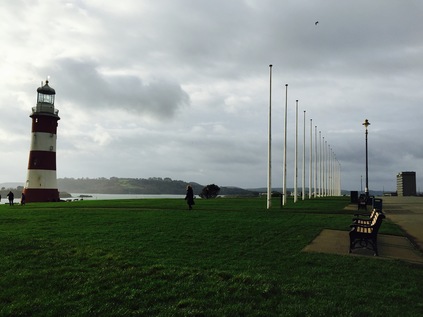
We set off home in the dark, a cosy train ride north to close our year. The train was quiet and warm, and I reflected on our travels. We hadn't managed to cover nearly the ground we'd hoped this year - but it looked like we could perhaps redress that a little now. As it was though, this trip was a good indication of how things should be - with places seen afresh and explored anew. It was a fitting way to end a tough but rewarding year, and a statement of intent for the next one.
There's no doubt that the last few weeks have been some of the most difficult and strange of my life, but also that strangely I've never felt more grateful for the people around me. It struck me too that, had things taken such a strange turn before I settled into this new way of life, I'd have been facing a time of change and sadness alone. It's almost certain that I'd have reacted by travelling - using movement as a refuge. Today, we decided to do just that.
We set our early in surprisingly bright sunshine. There was an uninspiring forecast, but for now at least the day appeared clear and bright - one of those days when clouds can suddenly obscure the sun turning the air cool for a moment. Last minute travel arrangements meant a seat in what was going to be a busy standard class coach, and when we boarded it became clear that First Great Western had decided not to include any seat reservations. Chaos followed, but somehow we managed to avoid any problems. Settled into our seats we watched Wiltshire and Oxfordshire slip by, soon arriving into Didcot Parkway. Didcot fares poorly in the national psyche somehow. It's station seems to be a byword for "neglected and beleagured" in comedic patter - and it's easy to see why. The cooling towers of the power station loom overhead, and the former yard - now a Great Western Society preservation site - stretches away from the platforms. Locomotives sit idling between trips. A lone trainspotter waits on the platforms, all his colleagues having probably gone to see the Western passing at Foxhall Junction instead. I've spent time here, enjoying a quiet morning with breakfast and trains, before heading into London - a split ticket here used to be the best value. Today though, it's quiet and we're heading around the curve into Oxford soon.
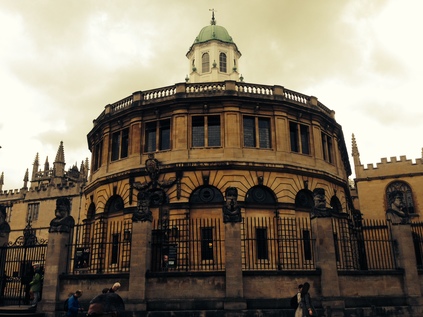
Given the dubious weather our strategy is to get the measure of the place first via the City Tour Bus. Boarding at the station, the first part of the journey is curiously bleak - edging past the stark, funereal Thatcher wing of the Said Business School and into the southern fringe of the city. This area was comprehensively redeveloped in the 1960s, when heritage wasn't a byword. Thus it's a mess of carparks, poorly built offices and shopping complexes. Passing the stumpy hillock which was Oxford Castle, the commentary on the bus urges us to picture scenes from medieval times - something we don't manage to conjure until the bus has turned north again and into the City Centre. At Carfax Tower we turn east and speed out to Magdalen College before skirting the centre again and heading north to St.Hugh's Collge and then south again among the university-owned villas and private houses to the city. With the weather determinedly grey but not yet wet, we hop out and start to explore on foot.
Our walk takes us first to Turl Street to find coffee, and then via the Bodleian Library and the vast Blackwell's book store. The rather unassuming, if attractive frontage fails to betray just how huge and meandering this shop is - and this isn't entirely obvious until The Norrington Room opens before us. As we head out, its clear that there is an event underway at the Sheldonian Theatre, as smartly attired parents shuffle into the building. We skirt the theatre, heading for the Radcliffe Camera and the courtyard of the Bodleian - both of which are captivating and rather other-wordly. Through the gates we glimpse the end of a graduation ceremony, with robed students milling and a rather larger than expected contingent of photographers pressed against the railing. Edging around Radcliffe Square we come upon All Souls' with Hawksmoor's handiwork more than evident. A glimpse through the gates shows the Wren sundial on the Codrington Library. As we push our cameras against the gate we're disturbed by a hubbub in the street. A photographer, trotting backwards and toting his huge lens, breathlessly says "turn around now and you'll get the shot of your life".
The next few moments are a blur. I spin and see graduates walking slowly from the Sheldonian, a line of photographers ahead of them snapping vigorously. A line of people pass flanking a graduate in her robes who flicks a glance back over her shoulder. It's newly graduated Dr. Chelsea Clinton. Suddenly the scene fits - the guys walking beside the party with earpieces are Secret Service. The tall, slim, tanned looking gent beside Chelsea is President Clinton, and on her other arm the shorter blue suited woman in a hat is Secretary of State Clinton. For both of us, it's our first near encounter with a living US President, and it's a strange mixture of excitement, confusion and disappointment that we weren't smart enough to see what was happening sooner and point our cameras.
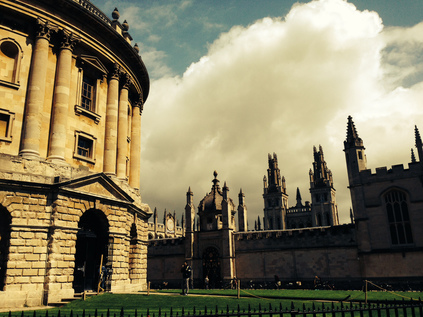
Eventually we follow the Clinton party out of the square, and find ourselves close to The Grand Cafe. My research before our trip had marked this out as a spot to visit, and sure enough it was an impressive interior with wonderful inter-war decoration. The service was a little haphazard, and the food pretty ordinary, but it felt like a fine place to reflect on the day so far. From her our walk took us into the quieter backstreets around Merton College and the wonderfully named Logic Lane before heading back to the station via a quick pint. With the sun now a little brighter and the day a touch warmer, we hopped on the tour bus to get us back to the station and thence homeward. It had been good to get out, and even better to explore a city which I'd hardly done justice to in the past. I can only hope the Clinton's had just as fine a time in Oxford today!
Having been in Seattle for a few days now, I was beginning to readjust to its unique rhythm. Our initial stay downtown had plunged me into the cosmopolitan, urban feel of the city which had begun, a long time back, to feel like a home away from home. This time I didn't feel like a stranger - more a returning ex-pat perhaps? It was interesting to prowl the streets early with Iain Sinclair's less than ringing endorsements from American Smoke in mind: tired, stressed and with a sick wife back at the hotel, he'd paced the city streets and seen only the gray reflections of clouds. Here for very different reasons, the silvery sheen of Elliot Bay reflected in tall glass blocks was like a visual sigh of relief. We'd made it. We were back.
But today, the pace changed again. With an extended visit to Montlake necessary, I had some time to cut loose and wander. A rare luxury in a trip with a packed itinerary and little scope for drift. With a Fuel coffee in hand I set off towards the Arboretum. I didn't intend to stray far - maybe to a quiet spot to read or write, while drinking? The edge of the park was abrupt, Lynn Street taking a ninety degree curve and the path heading into the trees. There were a few walkers dotted around, a bored woman scrolling listlessly at an iPad while her child clambered on the play equipment at the park entrance. I plunged into the trees feeling foreign and conspicuous, and far less acclimatised than I'd felt downtown. The tall evergreens closed around the path, and the unexpectedly clear sky all but disappeared as I pushed on. Turning a corner, a narrow but ornate bridge carried the path over the rush of Lake Washington Boulevard and into deeper wilderness. I was alone and comfortable at last. The path crested and turned north, with the rooftops of the Visitor Center below. A cursory glance at a pathside map had shown water up ahead, and my urge to walk near waterways was kindled. I edged through the drifting pedestrians and crossed the street near the Park entrance, plunging across to a viewpoint and a new path alongside an inlet of Union Bay. I sat for a moment and drained my coffee cup. It seemed wrong to have it along for this part of the walk somehow. Refreshed, I set off at a renewed pace - the slight edge of being in an entirely unknown place speeding my walk. The path meandered through dense trees and curved towards a road - the acoustic footprint of Highway 520 was near, but I had no sense of quite how near until the path dipped under a forbidding looking underpass. I was encouraged to see others passing through the concrete tunnel under the footings of the Evergreen Point Floating Bridge. Traffic pounded and echoed through the dingy gap, and only the sight of water on the other side of the span urged me to continue. I really had no sense of where I was headed. As it turned out, the scene quickly opened out into a busy, spacious picnic area on Foster Island. The lake surrounded three sides of the promontory, with a beachlike feel to the northern shore, where sailing boats scudded past at speed. The sun was high, and students from the nearby university lounged and occupied the picnic tables. I headed for the water's edge, before looking for the path off the island marked as the Marsh Trail.
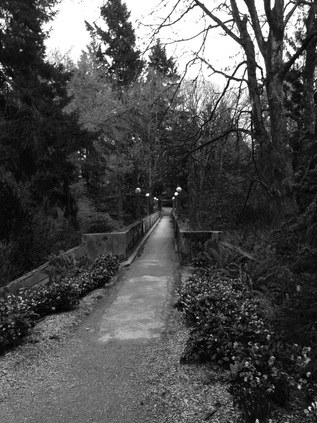
As I dived between two tall patches of rushes and scuffed along the bark trail, I realised that I was surrounded by water. This pathway floated on the scrubby marshlands at the edge of Lake Washinton. Indeed in some spots it was nearly submerged in the lake. Again, I was perturbed and considered a retreat, but the site of others coming towards me, apparently unscathed and not drenched spurred me on. The path zig-zagged out into the lake, a spur taking in a raised observation platform. Occasionally, an unguarded ramp would raise the path to wooden bridges which carried me out into clear water, descending onto further patches of marshy ground. Soon I was alone, a touch of concern arising as I really didn't know where the pathway led. A couple with a lolloping dog pursued me a distance back, and I decided to assume they knew where they were heading. They occasionally caught up as I paused to take pictures, their mutt shaking off lake water as he passed me, eliciting an apology as they overtook. The pathway descended another ramp onto Marsh Island, a boggy, half-formed mess of bark and reeds which gave a superb view across the lake to the Montlake Bridge. I resolved to get there if I could. Meanwhile the causeway and off-ramps of 520 soared above, the constant white-noise of tyres on concrete hissing ominously. From here, the scale of the tangled junction for Montlake was clear, including the 'ramps to nowhere' which it seems are a feature of road systems all over the world. Beneath the pillars, scrubby edgelands waited for reclamation. This was a zone which nature might just win back someday.
At a junction where the bark trail touched land I had a choice - continue on the shoreline, or ascend to the carpark of the former MOHAI museum site. The latter seemed a more likely way of getting to the bridge, so I turned towards the building. The empty gray hulk reflected the sounds of the highway back at me, deserted and ominous amongst the greenery of the park. Few cars were using the parking area, except for a Seattle Police vehicle which was criss-crossing the top of the ramp which led down to the lake. I didn't pause at the building - it's status wasn't clear to me, and I knew from previous experience how contrary the SPD could be. Instead I tried to look purposeful and followed the path towards the street. At the top, the cop was waiting for me: "Everything OK sir?". I replied in the affirmative and he asked me what I was doing. I told him I was walking and he asked where I was heading. Perhaps here is where I should have thought faster, or been less honest because I simply said "I'm interested in the bridge at Montlake. How do I get there?". His demeanour changed and he replied by asking if I was a tourist. I agreed I was, and he brightened visibly, before suggesting that I go downtown. "There's shopping, and the Space Needle. Nothing to see up here". I tried to explain that I was a walker, interested in canals and bridges, but he became more insistent that I shouldn't be in Montlake. Tourists belonged Downtown where they could be managed around the grid of the city. I decided that his growing coldness, his look of dismay and the handgun at his side were all good reasons to disappear. I thanked him and moved away towards the street, and he called after me that there were "...plenty of buses over there". I waved a hand behind me and struck up a pace. My experiences a summer ago had told me that some games were lost from the outset.
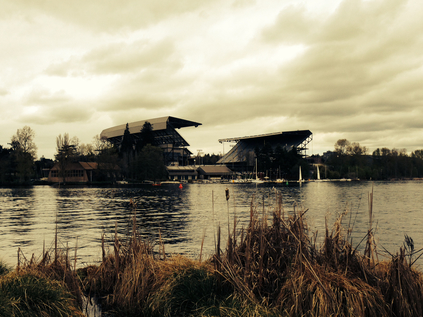
Once over the highway I cut along side streets which led me back to Montlake Boulevard. Recognising businesses and landmarks I felt a little proud of my navigation skills, and a little embarrassed that I'd let the cop send me off course so easily. Perhaps if he'd not found me inspecting an abandoned civic building he'd have been less concerned? Perhaps if I'd simply had a purpose to my walk? Even just getting from A to B seems better than "walking, just walking" as a descriptor to those people who find such things so terrifyingly inexact. I thought back to Iain Sinclair's miserable experience here, and despite my own brush with the gray edge of the city, still couldn't reconcile it.
You will shortly be able to see more pictures from the walk here. As an experiment, you can also follow the route on the map below - the blue line is the walking route.
View Arboretum & Marsh Island Walk in a larger map
Lost::MikeGTN
I've had a home on the web for more years than I care to remember, and a few kind souls persuade me it's worth persisting with keeping it updated. This current incarnation of the site is centred around the blog posts which began back in 1999 as 'the daylog' and continued through my travels and tribulations during the following years.
I don't get out and about nearly as much these days, but I do try to record significant events and trips for posterity. You may also have arrived here by following the trail to my former music blog Songs Heard On Fast Trains. That content is preserved here too.
